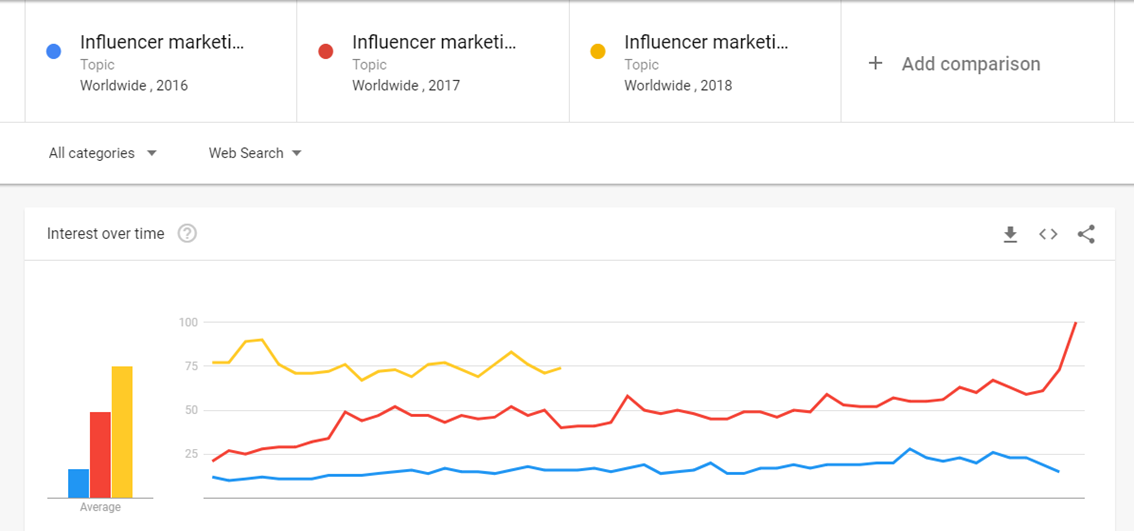Influencer marketing is one of the most effective strategies to increase your brand’s visibility, credibility, awareness, and ROI. According to Google, from 2016 to 2017 there was an increase of almost 200% in searches for the term “influencer marketing.” And as of June 2018, the average monthly searches have increased by 85% compared to June 2017. This reflects the tremendous growth of influencer marketing over the years. And it certainly doesn’t look like it’s going to slow down anytime soon. 
1. Analyze ROI
It’s important that you track the overall performance of your marketing campaigns. You must track campaign data such as engagement, sales, or views. Monitoring and tracking will provide you a clear idea of what’s working and what’s not. However, it turns out that 78% of marketers face difficulties when calculating and measuring ROI for their campaigns. When a campaign does not perform well and fails to meet your campaign goals, you must analyze how to manage your losses.
2. React to Updates
You need to be dynamic in order to be able to flourish and be successful on the internet. With the ever-changing internet trends, you must keep yourself updated with it and keep your content fresh. Big data can help you keep up with real-time changes, as it keeps track of profile activity and data in real-time. Let’s say an influencer has a massive reach, but their online activity is noticeably decreasing. Big data can help you unearth such situations and make you aware of the decline in the performance of the influencer. This can help you take any necessary steps in order to improve your campaign performance. Moreover, you can refer to this data and make sure that your campaign and influencers are performing well.
3. Find Key Influencers
It will take a lot of time and effort to search for and find a suitable influencer manually. The manual method is definitely not the optimum one to follow when looking for a relevant influencer. In fact, 67.6% of marketers agree that finding a relevant influencer is the toughest part of their campaigns. The good news is that, you can use big data to find to find the perfect influencers easily and quickly. Most influencer marketing platforms employ big data to create a pool of influencers from various niches, locations, and categories. So, leverage these databases to narrow down your search and find the best influencers in your niche. There are people who are serious about blogging and are looking to make a career out of it. Using big data, you can easily find suitable bloggers and influencers in your niche. Apart from finding influencers, big data can also help companies differentiate genuine influencers from the fake ones. You must be aware that having high follower counts doesn’t necessarily translate to influence. Using big data is one of the best ways to get an idea of real influence. This can include metrics such as engagement rates or follower growth rates. The degree of influence of an influencer can change in a matter of few weeks. When you measure influencer using big data, you will have a dependable set of numbers to work with. Only big data can adapt to changes of such data points in real-time, that’s why it’s the best.
4. Filtering Out Irrelevant Content and Data
In any influencer marketing campaign, influencers use multiple social platforms to get connected with the audience. And because they use more than one social platform, just imagine the amount of data you will have to work with. The job becomes next to impossible when you have a mix of relevant and irrelevant data to work with. Many a time, brands take irrelevant data into account for content analysis. For example, you may want to identify and delete fake and irrelevant content generated by internet trolls or bots. When analyzing your content, you need to skim through all content carefully to check if they’re relevant or not. For example, if Nike were to conduct content analysis by tracking the mention of #JustDoIt, they’re bound to come across a lot of irrelevant content. And eventually, they will need to filter it out from their analysis. Let’s take a look at what a relevant and an irrelevant post for Nike might look like. Here’s what a relevant post for Nike might look like:
Final Thoughts
The popularity and use of influencer marketing are growing at impressive rates. The more they grow, the harder it becomes for brands to manage, analyze, and track their campaigns manually. By using big data and analytics, you can run your influencer marketing campaigns much more efficiently. Collaborating with relevant influencers will surely help your brand. But if you are not using big data analysis for your influencer marketing campaigns, chances are high that your campaign may fall flat. So, leverage big data and win with influencer marketing. If you know any other ways to use big data for influencer marketing, please let us know in the comments below.